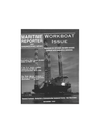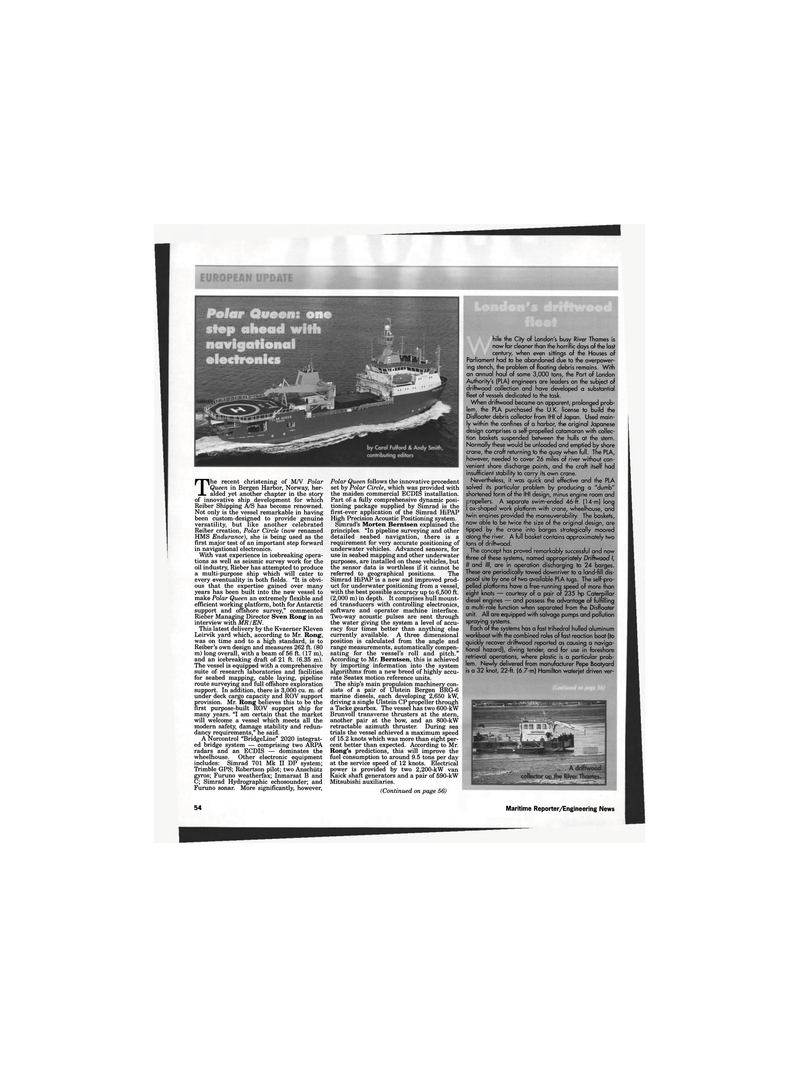
Page 52: of Maritime Reporter Magazine (November 1995)
Read this page in Pdf, Flash or Html5 edition of November 1995 Maritime Reporter Magazine
The recent christening of M/V Polar Queen in Bergen Harbor, Norway, her-alded yet another chapter in the story of innovative ship development for which
Reiber Shipping A/S has become renowned.
Not only is the vessel remarkable in having been custom-designed to provide genuine versatility, but like another celebrated
Reiber creation, Polar Circle (now renamed
HMS Endurance), she is being used as the first major test of an important step forward in navigational electronics.
With vast experience in icebreaking opera- tions as well as seismic survey work for the oil industry, Rieber has attempted to produce a multi-purpose ship which will cater to every eventuality in both fields. "It is obvi- ous that the expertise gained over many years has been built into the new vessel to make Polar Queen an extremely flexible and efficient working platform, both for Antarctic support and offshore survey," commented
Rieber Managing Director Sven Rong in an interview with MR/EN.
This latest delivery by the Kvaerner Kleven
Leirvik yard which, according to Mr. Rong, was on time and to a high standard, is to
Reiber's own design and measures 262 ft. (80 m) long overall, with a beam of 56 ft. (17 m), and an icebreaking draft of 21 ft. (6.35 m).
The vessel is equipped with a comprehensive suite of research laboratories and facilities for seabed mapping, cable laying, pipeline route surveying and full offshore exploration support. In addition, there is 3,000 cu. m. of under deck cargo capacity and ROV support provision. Mr. Rong believes this to be the first purpose-built ROV support ship for many years. "I am certain that the market will welcome a vessel which meets all the modern safety, damage stability and redun- dancy requirements," he said.
A Norcontrol "BridgeLine" 2020 integrat- ed bridge system — comprising two ARPA radars and an ECDIS — dominates the wheelhouse. Other electronic equipment includes: Simrad 701 Mk II DP system;
Trimble GPS; Robertson pilot; two Anschiitz gyros; Furuno weatherfax; Inmarsat B and
C; Simrad Hydrographic echosounder; and
Furuno sonar. More significantly, however,
Polar Queen follows the innovative precedent set by Polar Circle, which was provided with the maiden commercial ECDIS installation.
Part of a fully comprehensive dynamic posi- tioning package supplied by Simrad is the first-ever application of the Simrad HiPAP
High Precision Acoustic Positioning system.
Simrad's Morten Berntsen explained the principles. "In pipeline surveying and other detailed seabed navigation, there is a requirement for very accurate positioning of underwater vehicles. Advanced sensors, for use in seabed mapping and other underwater purposes, are installed on these vehicles, but the sensor data is worthless if it cannot be referred to geographical positions. The
Simrad HiPAP is a new and improved prod- uct for underwater positioning from a vessel, with the best possible accuracy up to 6,500 ft. (2,000 m) in depth. It comprises hull mount- ed transducers with controlling electronics, software and operator machine interface.
Two-way acoustic pulses are sent through the water giving the system a level of accu- racy four times better than anything else currently available. A three dimensional position is calculated from the angle and range measurements, automatically compen- sating for the vessel's roll and pitch."
According to Mr. Berntsen, this is achieved by importing information into the system algorithms from a new breed of highly accu- rate Seatex motion reference units.
The ship's main propulsion machinery con- sists of a pair of Ulstein Bergen BRG-6 marine diesels, each developing 2,650 kW, driving a single Ulstein CP propeller through a Tacke gearbox. The vessel has two 600-kW
Brunvoll transverse thrusters at the stern, another pair at the bow, and an 800-kW retractable azimuth thruster. During sea trials the vessel achieved a maximum speed of 15.2 knots which was more than eight per- cent better than expected. According to Mr.
Rong's predictions, this will improve the fuel consumption to around 9.5 tons per day at the service speed of 12 knots. Electrical power is provided by two 2,200-kW van
Kaick shaft generators and a pair of 590-kW
Mitsubishi auxiliaries. (Continued on page 56) hile the City of London's busy River Thames is now far cleaner than the horrific days of the last century, when even sittings of the Houses of
Parliament had to be abandoned due to the overpower- ing stench, the problem of floating debris remains. With an annual haul of some 3,000 tons, the Port of London
Authority's (PLA) engineers are leaders on the subject of driftwood collection and have developed a substantial fleet of vessels dedicated to the task.
When driftwood became an apparent, prolonged prob- lem, the PLA purchased the U.K. license to build the
Disfloater debris collector from IHI of Japan. Used main- ly within the confines of a harbor, the original Japanese design comprises a self-propelled catamaran with collec- tion baskets suspended between the hulls at the stern.
Normally these would be unloaded and emptied by shore crane, the craft returning to the quay when full. The PLA, however, needed to cover 26 miles of river without con- venient shore discharge points, and the craft itself had insufficient stability to carry its own crane.
Nevertheless, it was quick and effective and the PLA solved its particular problem by producing a "dumb" shortened form of the IHI design, minus engine room and ropellers. A separate swim-ended 46-ft. (14-m) long ox-shaped work platform with crane, wheelhouse, and twin engines provided the maneuverability. The baskets, now able to be twice the size of the original design, are tipped by the crane into barges strategically moored along the river. A full basket contains approximately two tons of driftwood.
The concept has proved remarkably successful and now three of these systems, named appropriately Driftwood I,
II and III, are in operation discharging to 24 barges.
These are periodically towed downriver to a land-fill dis- posal site by one of two available PLA tugs. The self-pro- pelled platforms have a free-running speed of more than eight knots — courtesy of a pair of 235 hp Caterpillar diesel engines — and possess the advantage of fulfilling a multi-role function when separated from the Disfloater unit. All are equipped with salvage pumps and pollution spraying systems.
Each of the systems has a fast trihedral hulled aluminum workboat with the combined roles of fast reaction boat (to quickly recover driftwood reported as causing a naviga- tional hazard), diving tender, and for use in foreshore retrieval operations, where plastic is a particular prob- lem. Newly delivered from manufacturer Pepe Boatyard is a 32 knot, 22-ft. (6.7-m) Hamilton waterjet driven ver- 54 Maritime Reporter/Engineering News

 51
51

 53
53
